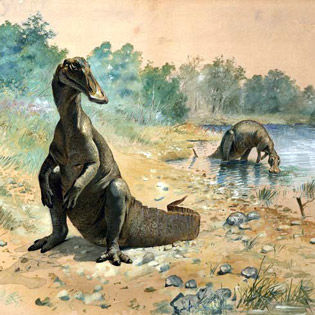Victorian Dinosaurs: Facts and Fictions of the Nineteenth-Century Mesozoic
- Location
- Birmingham and Midland Institute
- Dates
- Thursday 15 February 2018 (18:00-19:30)
 Knight Hadrosaurs
Knight Hadrosaurs
Dr Will Tattersdill explores Victorian Dinosaurs at the Birmingham and Midland Institute.
In 1842, Richard Owen coined the term 'dinosaur' to describe three recently-discovered extinct animals from the Age of Reptiles. He could not have foreseen the enormously varied associations his word would accrue over the twentieth and twenty-first centuries: far outside the professional, scientific realm in which it was first used, 'dinosaur' now conjures images not only of petrified bones, nor even of the flesh and blood creatures from which they came, but of plastic, of plush, of cell-shading, and of CGI. Dinosaurs are in our museums, but they are also in our cinemas, in our homes, and in the stories we tell to our children. They are even flocking on Centenary Square, as we now know that modern birds are the direct descendants of the therapods which survived the asteroid strike of 65 million years ago.
Dinosaurs are everywhere, and they mean different things to different people. Throughout this diaspora of meaning, though, we routinely find that ‘the Victorian’ remains indelibly associated with these creatures (their relationship to modern birds, for instance, was first lit upon by T. H. Huxley in the late nineteenth century). In steampunk, in palaeoart, and even in the ways museums mount specimens we can still trace the influence of the Victorian Dinosaur. Does this simply reflect the nineteenth-century roots of modern palaeontology, or is something deeper at work? In this talk, I’m going to suggest that our relationship with history – our own, as well as the geological deep time in which the dinosaurs really did roam the Earth – can be usefully illuminated by considering how humans have understood their relationships with these prehistoric beasts. It’s not a coincidence, I’m going to argue, that ‘Victorian’ and ‘dinosaur’ are often used interchangeably today in order to suggest something that is extinct, redundant, or obsolete – in both cases, the associations themselves are fascinating largely because of how completely unconvincing they are.
£5/£3 for members of the BMI